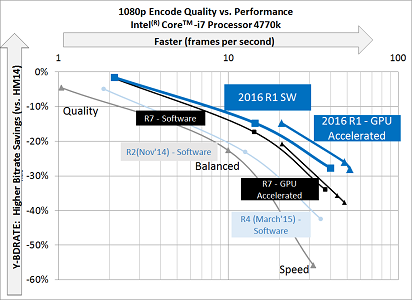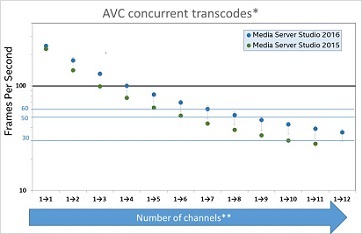New features in Intel Media Server Studio 2016
 With the release of the new version of Intel Media Server Studio 2016, fast and high-quality video transcoding has become even easier and more accessible! HEVC encoder has become 1.1 times more productive, and the quality has increased by 10%. Intel Media Server Studio helps solution providers encode HEVC 4K video for broadcast using a dedicated Intel Xeon E3-based Intel Visual Compute Accelerator expansion card in combination with some Intel Xeon E51 processors. Improving the stability of the decoding AVC and MPEG2 allows you to handle errors in the video. For details on the new features for multimedia transcoding, see below.
With the release of the new version of Intel Media Server Studio 2016, fast and high-quality video transcoding has become even easier and more accessible! HEVC encoder has become 1.1 times more productive, and the quality has increased by 10%. Intel Media Server Studio helps solution providers encode HEVC 4K video for broadcast using a dedicated Intel Xeon E3-based Intel Visual Compute Accelerator expansion card in combination with some Intel Xeon E51 processors. Improving the stability of the decoding AVC and MPEG2 allows you to handle errors in the video. For details on the new features for multimedia transcoding, see below.Intel is a leader in accelerating multimedia and cloud computing. Thanks to the power of the Intel and Intel Media Server Studio processors, we are helping multimedia solution providers, broadcasters and infrastructure developers to create new solutions and achieve high performance, efficiency and high quality in multimedia applications and broadcast video over the Internet.
Download Media Server Studio 2016
» For registered users (login required)
» For new users: get a free Community edition, get acquainted with the Pro edition or buy
10% increase in HEVC performance and quality (H.265), use of advanced GPU analysis, bit rate reduction
Professional Edition
- Up to 10% better performance and quality of GPU-accelerated (GACC) HEVC encoders allow you to encode 4K HEVC video in real time with broadcastable quality on some Intel Xeon E5 platforms using Intel Visual Compute Accelerator (Intel VCA)
') - Even more, the performance of the HEVC GPU-accelerated encoder now helps to load cyclic filters, such as deblocking (DBF) and sample adaptive offset (SAO) on the GPU (in previous versions, these filters were executed on the CPU).

Figure 1. In the version of Media Server Studio 2016, the video encoding efficiency is increased by 10% compared with the 2015 version of R7. In addition to the above, the new version also supports real-time encoding of 1080p video at 50 frames per second on platforms with previous-generation Intel Core i7 and Xeon E3 **. The quality-to-performance ratio of the software implementation (calculations occur only on the CPU) and GPU accelerated (calculations are performed on the execution units of the GPU) HEVC coding for 8-bit video data 4: 2: 0, 1080p. The baseline quality score corresponds to the ISO standard HM14 (0%) and is calculated using the Y-PSNR BDRATE curves. Performance - the average between four bit rates taken in the range from low (average 3.8 MB / s) to high (average 25 MB / s). See here for more information.
Thanks to the new features of Intel VTune Amplifier , it becomes easier for developers to receive and interpret data on GPU usage and on performance of OpenCL * and Intel Media SDK applications . It also supports load parallelization analysis between a CPU and a GPU, analysis of how a GPU works using hardware metrics, a GPU architecture diagram, and much more.
Reduction of data when using the HEVC codec due to coding based on workspaces (ROI). Certain work areas can be packaged with the least degree of compression to preserve the greatest detail compared to other areas. This feature improves the performance of video conferencing applications. To use it, you must set the mfxExtEncoderROI structure in the application to specify different working areas when encoding. This can be done at initialization or at run time.
Video conferencing - speed up your video conferencing applications with special HEVC mode with low latency.
New features to work with 8K resolution : do not limit your application the ability to encode video with 4K resolution. Software and GPU-accelerated Intel HEVC codecs in Media Server Studio 2016 support 8K encoding.
Improvements in AVC (H.264) and MPEG2 decoding
Media Server Studio Community, Essentials, Professional
Advanced 5th generation graphics and multimedia processing accelerators, along with their own drivers, enable transcoding up to 16 HD AVC streams with high real-time quality to each Intel Xeon E3 v4 processor (or using Intel VCA) 1 through the use of hardware acceleration.
Up to 12 HD AVC streams on 4th generation Intel Core processors with Intel Iris ** graphics.
Use enhanced AVC encoding quality for BRefType MFX_B_REF_PYRAMID.
The AVC and MPEG2 decoder has become more stable in handling damaged streams and errors . The enhanced stability of AVC and MPEG2 decoding ensures stable output and flawless processing of damaged video content. Additional error messages will help developers find and analyze decoding errors more quickly.

Figure 2. Media Server Studio 2016 achieved an increase in performance of AVC (H.264) codecs by 40% compared with version 2015 due to improved hardware load scheduling algorithms **. This picture shows the results of encoding multiple H.264 streams from a single H.264 source file using a multi_transcode sample (available as part of the code examples). Each point corresponds to the average value for 4 video streams and 6 bitrate values. The measurements were made with the Target Usage 7 (TU7) value, which corresponds to the work with the highest speed (and the lowest quality). [1080p video at 50 frames per second obtained from media.xiph.org/video/derf/: crowd_run, park_joy (30mbps input; 5, 7.1, 10.2, 14.6, 20.9, 30 mbps output; in_to_tree, old_town_cross 15 mbps input, 2.5, 3.5, 5.1, 7.3, 10.4, 15 mbps output).] Configuration: simultaneous transcoding of AVC1 → N with different data rates, 1080p, TU7, Intel Core i7-4770K processor with a frequency of 3.5 GHz **. The number of 1080p channels with different data rates.
Other improvements
Improvements to the Intel SDK for OpenCL Windows applications include new kernel development features.
Added CTB-level delta QP support for all quality presets, i.e. Target Usage 1 through 7 inclusive for all data rate control modes (CBR, VBR, AVBR, ConstQP) and all profiles (MAIN, MAIN10, REXT).
Supports IPPP..P stream encoding, i.e., without B-frames, using generic P-and B-frame management for applications in which B-frames are removed to meet network bandwidth requirements.
H.264 encoding works directly with ARGB surfaces (obtained from the screen or from games) and YUY2, which reduces preprocessing costs (i.e., converts the color space from RGB4 to NV12 for processing in the Intel Media SDK), improves performance screen capture .
Save time using updated code samples
The ability to use filters for video stream processing (VPP), such as composition (composition), noise removal (denoising), edge detection (detail), frame rate control (FRC), deinterlacing, color space conversion has been added to the sample_multi_transcode sample . (CSC).
In sample_decode in the sample package for Linux, video rendering with DRM is supported, for which you need to use the input argument “-rdrm”. Now sample_decode and sample_decvpp are combined into one sample for decoding, where new VPP filters have been added, such as de-interlacing and color space conversion.
additional information
The above are just some of the most significant features and enhancements in Media Server Studio 2016. Visit the product site and read the documentation for more information.
Essential / Community Release Notes: Windows , Linux
Release Notes for Professional Edition: Windows , Linux
Source: https://habr.com/ru/post/283394/
All Articles